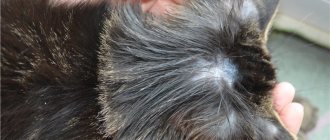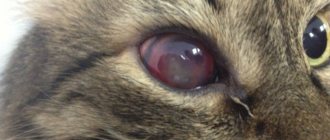The causes of skin diseases in cats are different, but “uninvited residents”, that is, fleas, can become irritants. To exclude this possibility, you should bathe your pet by treating it with a special shampoo. No flea collars should be worn; they can irritate the skin. If the fleas are removed, but the problems remain, you need to evaluate the general condition of the body. Symptoms of skin diseases in cats at the initial stage are as follows:
- itching;
- red spots inside the ear, in the armpits, in the groin area, on the stomach and neck;
- local hair loss;
- increased separation of scales in the form of dandruff (more noticeable on dark-colored cats);
- peeling of the skin;
- the appearance of weeping;
- various types of rashes.
First of all , if a cat has wounds on the neck, you should think about the pet’s diet. They, like people, are susceptible to food allergies. Congenital predisposition is recorded by veterinary statistics in white cats.
To replenish the supply of vitamins, you need to grow oats in a tray and feed the cat grass.
If your pet constantly eats store-bought food, there is a high probability of disruption of the internal organs. The cat should be switched to natural food: boiled fish (cleaned of bones), fish soup without salt, boiled meat and, as a delicacy, lightly boiled liver (1-2 minutes).
Causes of itching in the head and neck area in cats
Cats scratch their necks until they hurt for a variety of reasons. This behavior is provoked by external factors, ectoparasites and a number of diseases of varying degrees of danger. The largest number of cases are due to allergies and insect parasites. A smaller percentage of the probability is associated with viral, autoimmune and other diseases.
Ectoparasitosis
Otodectes cynotis, or ear scabies, is caused by mites. They settle in the ears or ear canal and cause severe itching in the cat. As a result, she regularly shakes her head and scratches her ears until they hurt. It is transmitted by contact and affects mainly young animals.
Notoedrosis or pruritic scabies develops against the background of Notoedres cati tick bites. The disease is characterized by inflammation of the scalp, hair loss and severe itching. An infected cat constantly scratches its head until sores appear.
Important! Notoedres cati itches spread from cats to other animals and even humans. For some time they cause pseudo-scabies and then go away, since there are no favorable conditions for life.
Cheyletiellosis, or wandering scabies, is caused by Cheyletiella mites. The fact that a cat has these parasites is indicated by severe itching and fine dandruff. The disease often spreads to humans and causes an itchy rash.
Demodectic mange or ironworm is the result of exposure to mites of the genus Demodex. They develop their vital activity in the sebaceous glands and hair follicles. As a result, bald patches of skin and sores appear on the cats’ faces. The areas most commonly affected are the areas around the eyes and mouth, as well as the front legs.
Fleas are a common cause of scratching on the neck and other parts of the body. They parasitize primarily on cats and dogs. They can also temporarily transfer to humans. When infected with them, a large number of black crumbs appear under the fur of pets. These flea droppings are especially noticeable in the lumbar and back areas.
The animals themselves itch very much to the point of soreness, as they experience severe itching at the bite sites.
Allergies
A common reason why a cat scratches itself until it hurts is allergies. It implies an abnormal reaction of the body to a stimulus. When first hit, protective cells create an antidote and “remember” the allergen. And if it penetrates again, a violent reaction occurs in the body. It leads to inflammation, itching and other symptoms.
Allergies cause several diseases in cats:
- atopic dermatitis;
- flea dermatitis;
- food allergies;
- contact dermatitis.
Flea dermatitis
Flea dermatitis is a common reason why a cat scratches itself until it hurts. When one flea bites, it releases a special anticoagulant into the cat's skin. This substance prevents blood clotting. The pet becomes sensitized to it. And the body reacts to the bites of other fleas in the form of inflammatory processes, rashes and papules.
The affected areas are very itchy. The cat begins to behave restlessly and reacts nervously to touch. This type of dermatitis occurs in two forms: chronic and latent. In the first case, alopecia (foci of baldness) and nodules with flea feces develop on the body. The second is characterized by the appearance of papules with a red rim.
The cat begins to tear them apart until they hurt. Often secondary infection is associated with wounds.
Atopic dermatitis
The disease is typical for young animals aged 1 to 3 years. The main reason for its appearance is the uncontrolled selection of cats. As a result, animals develop allergies to dust and pollen. In this case, it is almost impossible to identify the allergen.
Important! Atopic dermatitis has no cure; cats will regularly scratch their skin until it hurts. The action of therapy is aimed at suppressing symptoms.
Dermatitis in cats manifests itself with the following symptoms:
- the appearance of dandruff on the withers and back;
- hair loss;
- labored breathing;
- discharge from the eyes and nose;
- cough;
- profuse salivation.
Contact dermatitis
This allergy is similar in symptoms to atopic dermatitis. It often manifests itself when the pet comes into contact with household chemicals, toilet filler, the hair of other animals, and flea products. Contact allergies are manifested by severe itching, flaking of the skin and a small rash. Often a cat itches until it hurts. And this increases the risk of secondary infections.
Food allergies
Allergens can accumulate in the body of animals. With their regular consumption, health problems begin. Food allergies are characterized by:
- the appearance of a rash on the cat’s neck and head;
- hair loss;
- the appearance of dandruff;
- inflammation of the eyelids;
- unpleasant odor from the mouth.
Important! Symptoms of food allergies in cats are often accompanied by vomiting and indigestion.
A common cause of food allergies is feeding cats salted, fried, smoked and other prohibited foods from the table. Mixed feeding with industrial feed and natural products also contributes to its appearance.
What to do if your cat scratches its neck until it hurts and bleeds
In any case, scratching the skin to the point of wounds should be a reason to take the cat to the veterinarian. Even if the cause is simple, the doctor will be better able to assess the animal’s condition and prescribe the most effective treatment. The range of therapeutic measures will depend entirely on the source of the itching.
Table: method of treatment depending on the type of disease
| Type of disease | Treatment |
| Demodicosis | Long-term (from 6 to 12 months), including a set of measures:
|
| Helminthiasis | Special anthelmintic drugs are used:
|
| Bacterial infection |
|
| Eczema |
|
| Allergy |
|
| Dermatomycoses | Treatment takes on average 1–2 months:
|
Photo gallery: drugs for the treatment of itchy wounds on the neck of cats
Imaverol for cats - emulsion for external use, a broad-spectrum medicine for various types of fungal infections
Stronghold has a complex antiparasitic effect
Miramistin - an antiseptic for treating wounds
Triderm is a hormonal ointment that accelerates healing and relieves inflammation
Vakderm is a vaccine against fungal infections used for cats for therapeutic and prophylactic purposes. Cetirizine suppresses allergic reactions.
It is worth understanding that itching and wounds due to scratching are only a manifestation and consequence of the disorder, so the problem will not disappear until its source is eliminated . Before going to the clinic, the owner should try to alleviate the animal’s condition. Bleeding wounds must be treated with an antiseptic (chlorhexidine, Miramistin, hydrogen peroxide), which will reduce the risk of secondary infection. You cannot carry out any activities with cosmetics - bathing with shampoo, applying creams, coat powders, etc.
If a cat develops lichen and the owner decides to give his pet a bath, this will only worsen the situation - the spots will “spread” all over the body very quickly.
It is also recommended to adjust the diet and exclude all those foods that are prohibited for animals (bread, bagels, sweets, sausages - products from the common table), since an unbalanced diet negatively affects the condition of the skin and can aggravate the course of diseases.
Video: sores on a cat’s neck - what to do
Skin infections
Scratched cat sores on the neck and head in some cases occur due to infectious diseases. Cats with access to the outdoors are especially susceptible to them. When a bacterial infection of the skin occurs, one of two forms develops:
- Dry. Dry crusts, dandruff and scabs form on your cat's neck.
- Wet. It is characterized by the appearance of blisters and ulcers with liquid contents inside.
Animals with sensitive skin are predisposed to eczema. It develops through prolonged contact with flea collars, harnesses, after insect bites and skin parasites.
Important! Diabetes mellitus, neuropathy and hormonal changes contribute to the appearance of eczema.
A rash and blisters appear on the pet's body. Severe itching leads to the cat scratching its neck until it bleeds, and sores appear that do not go away for a long time. To eliminate eczema, antibacterial therapy, various ointments and powders are prescribed.
Viral dermatoses
Cat scratching on the skin is also characteristic of viral dermatoses. The herpes virus affects the eyes and respiratory tract of the animal, often manifesting itself as skin lesions. They are often localized in the area of the nose and eyes, less often on the paws and stomach.
Feline herpes is characterized by:
- bloody stains;
- small rash;
- swelling of the skin;
- small scabs on the neck, sores on the head.
Skin changes appear 1.5 weeks after the disappearance of conjunctivitis and other characteristic symptoms.
Cowpox or poxvirus is a rare disease. It can enter the cat's body through the bites of small rodents. It manifests itself as skin lesions in the form of nodules and small ulcers. With good immunity, it goes away on its own. In weakened animals there is a risk of developing a severe form.
Autoimmune dermatoses
Autoimmune diseases are characterized by an abnormal reaction of the immune system to its own tissues and cells. Skin manifestations on the body of cats are characteristic of several diseases:
- Common pemphigus. It is characterized by the development of ulcers in cats around the mouth and in its cavity itself. Involves long and difficult treatment. It often ends critically for animals.
- Erythematous pemphigus. Crusts, ulcers, blisters, sores and other lesions are concentrated in the area of the animal’s nose and bridge of the nose. Sometimes the disease is accompanied by a change in skin color.
- Pemphigus foliaceus. The main symptom is the appearance of large pustules on the skin near the mouth and ears. Associated signs in cats include elevated body temperature, refusal to eat, and apathy.
- Systemic lupus erythematosus. It affects all systems and organs of the animal. Wounds on the scalp manifest themselves through depigmentation of the skin, the development of a rash and the subsequent formation of ulcers.
Rules for treating wounds at home
Having noticed any damage on the body of your beloved pet, you need to know how to properly treat a cat’s wound. Proper and timely assistance is the key to successful healing and the elimination of possible complications.
First of all, the owner must carefully examine the type of wound, then trim the hair in the area of damage using nail scissors. Possible foreign bodies are carefully removed from the wound - wool, fragments, thorns. If blood clots or purulent exudate are detected, they must be carefully removed without damaging the crust inside the wound, so as not to provoke trauma to the vascular walls and bleeding.
It is necessary to treat an open wound after thoroughly removing dirt. Hydrogen peroxide is excellent for these purposes (it is better to use a 3% solution). You can use a weak solution of potassium permanganate. The edges of the damaged surface are treated with iodine solution or brilliant green.
A large wound requires the application of sterile tissue (preferably a bandage), without the use of cotton wool. This is due to the fact that cotton wool fibers can get into the wound, causing additional complications in the form of suppuration.
Heavy bleeding from the wound after a bite is stopped by applying a tourniquet or a well-compressive bandage. A damaged artery and the accompanying pulsation of scarlet blood from the wound imply the immediate application of a tourniquet above the damage. If the blood flowing from the wound is dark, rich cherry color (venous), then a tourniquet is applied below the wound.
There is some helpful advice when applying wound dressings for cats. To prevent the animal from pulling off the bandage and licking it off, the bandage is first dipped in a solution of chamomile or sage. The bandage must be changed regularly. Levomekol ointment will help speed up the process of tissue regeneration. This antibiotic-based drug not only prevents the proliferation of pathogenic microflora, but also eliminates pain.
Detected serious injuries with severe bleeding require contacting a veterinarian. He will not only help stop hemorrhage, but will also prescribe a course of treatment with antimicrobial agents.
In some cases, with large wounds, the veterinarian will administer local anesthesia and stitch the edges of the wound (only in case of immediate treatment). In later cases of treatment, suturing of the wound edges is not carried out due to the fact that the suture material can provoke the development of inflammatory and necrotic processes.
Antibiotics for cats with purulent wounds are necessary, but they should be prescribed by a specialist, taking into account the individual characteristics of the patient’s body. Common antimicrobial agents for preventing the purulent-necrotic process in the tissue structures of the wound are Baytril, Sinulox, Amoxiclav.
There are several basic rules that are important to follow so that the wound heals faster and damaged tissue heals. First of all, it is necessary to regularly change the bandage applied to the wound (in some cases 2-3 times a day). If there is complete absence of discharge from the damaged area, the dressings are canceled. Treatment of purulent wounds in cats requires regular examination by a specialist who will help adjust the course of therapy if necessary.
When changing the dressing material, it is necessary to treat the wound each time. It is also important to ensure that the animal does not lick or scratch the wound. Drainage placed, if necessary, is removed 5 days after the injury, but the suture material used to suture the edges of the wound is removed after 10-14 days.
Find out also how to treat a bruise in a cat>>>
Skin tumors
Skin neoplasms are in first place among oncological diseases in animals. By their nature, they are also divided into benign and malignant forms.
The first includes:
- Basalioma. The sore is a pigmented dome-shaped tumor. At the point where it appears, the animal loses its hair.
- Cutaneous histiocytoma. Characterized by a rapidly growing tumor under the skin. A rare pathology for cats.
Malignant skin tumors develop in two cases:
- Squamous cell carcinoma. The disease manifests itself in the nose, eyelids and ears. Metastases spread through the lymphatic system.
- Basal cell carcinoma. Develops from basal cells of the skin. Characterized by rapid growth and a high probability of metastasis.
A cat has sores on its neck and hair is falling out: Where to go?
Saint Petersburg:
- Sotnikov Veterinary Clinic. One of the best clinics in Russia. They deal with both complex cases that require a consultation of doctors, as well as simpler ones. The clinic's doctors are lecturers at conferences aimed at improving the skills of other doctors.
- Vetnet. Specialists will make an accurate diagnosis quickly. Quality treatment will be prescribed.
- Vetus. Top-class veterinary dermatologists work here.
Moscow:
- Medea. A wide range of veterinary services from nail trimming to ultrasound. There is a hospital. Doctors make decisions quickly and efficiently, prescribe only the necessary diagnostics and treatment without frills.
- Clinic Gav. 20% discount on consultations without animals. Friendly staff. Convenient location.
- Your doctor. Renowned dermatologists provide appointments by appointment. It is possible to immediately carry out all diagnostic procedures if the pet is properly prepared. You can always find out more information by phone or on the clinic’s website.
Rostov-on-Don:
- Center. One of the best clinics in Rostov-on-Don. Visitors note the abundance of pet products in the pharmacy. They speak positively about the staff, both administrators and doctors.
- Animal friend. High-class specialists will provide quick and high-quality assistance to your pet if you contact them in a timely manner. There is a flexible system of discounts. Friendly administrators will help and explain everything.
- Veterinary clinic of Dr. Zarubin. The initial appointment is only 200 rubles. Other manipulations are performed according to the price list. The experience of doctors allows us to quickly make an accurate diagnosis and prescribe treatment.
Quantity
History taking
Diagnostics will help you understand why your cat scratches its neck and what caused the sores. But before carrying it out, the veterinarian needs to collect an anamnesis.
Age and breed
A kitten up to one year old is susceptible to skin and subcutaneous parasites. Young animals suffer predominantly from allergic reactions. If an elderly cat scratches its neck until it bleeds and hurts, this may be due to autoimmune dermatoses.
The breed of the animal also leaves its mark. Persian cats are prone to dermatophytosis and dermatitis, while Sphynx cats are prone to allergies and neoplasms.
Lifestyle
A large number of animals in one area, access to the street, participation in cat shows and other factors increase the risk of infection with parasites and viral diseases.
Seasonality
Allergies to pollen, bee or mosquito bites have a pronounced seasonality. Flea dermatitis in cats manifests itself regardless of the time of year. But it is most common in August-September.
The cat has sores on its head and hair has come out: Causes
Many factors can contribute to hair loss and the appearance of wounds on a cat’s head, neck, withers and other parts of the body:
- Flea infestations and other parasites can cause itching, self-induced alopecia, and dermatitis.
- Allergy. It can be different: to components of the diet, to something from the environment.
- Contact dermatitis. It often occurs at the site where flea drops are used or when medications are administered subcutaneously. Crusting is often reported with Baytril injection in cats.
- Other inflammatory and non-inflammatory processes in the dermis.
Diagnostic methods
Diagnostics will help determine why a cat scratches its neck until it hurts. The doctor prescribes one or more methods:
- Combing wool. A fine comb is used for this. The procedure allows you to see fleas, lice and skin mites on cats. Can be done independently at home.
- Trichogramma. Determines the presence of spores and eggs on the hair shaft.
- Examination of earwax under a microscope. It is carried out if otodectosis is suspected.
- Wood's lamp. Shows the glow of spores on the skin of an animal from certain types of fungus.
- Cytological examination. The veterinarian recommends this to detect yeast and bacterial infections.
- Allergy test. Prescribed for confirmed atopic allergies in cats.
- Skin scraping. Detects ticks, their larvae, and spores.
- Elimination diet. Prescribed by a veterinarian to determine the allergen for food allergies.
- Fungal culture. An effective method for dermatophytes.
Parasites in cats
Most often, the cause of the disease is parasites. They choose the softest and warmest places on the cat's body. For example, the neck or the area under the animal’s paws. Such parasites can be fleas and ticks. However, basically it is not they themselves that cause the disease, but the components of their vital activity. Saliva, getting under the pet's skin, triggers an allergic reaction mechanism. The cat feels itchy and scratches the bite sites. Further, bacteria enter the wounds and the already complicated course of the disease begins.
The owner of the animal first of all needs to pay attention to the restless behavior of his pet.
Carefully examine the skin and if fleas or ticks are found, treat for parasites. In any case, you need to contact a veterinary clinic. To make sure that the body’s reaction was really to parasites.
If the cat itches, but the owner does not find fleas, then perhaps the cause is ticks. Subcutaneous parasites can only be detected by a veterinarian. After performing certain tests, the doctor makes a diagnosis and prescribes treatment. Most often, cats are given Ivermek injections. Three intramuscular injections are required at intervals of ten days.
It happens that there is no opportunity to visit the veterinarian, and the cat scratches itself. In this case, you should try to purchase the same medicine, but in gel form and smear it on the animal.
The cat is constantly itching: type of itching and diagnosis
If, when a breeder visits a veterinary clinic with a complaint that the cat is itching a lot, the specialist immediately prescribes flea treatment without establishing the presence of parasites, you should change the clinic. The rules of the RosVet VC state that the first thing people pay attention to is the type of itching:
- the cat licks and scratches;
- gnaws the body (paws);
- against the background of scratching, he has extensive bald patches (alopecia on the stomach and thighs).
In the future, the doctor follows the standard algorithm for diagnosing pathologies that are accompanied by scratching. A detailed analysis allows us to determine the cause:
- medical history (duration of itching, type of feeding and type of feed, presence/absence of antiparasitic treatment, possibility of allergies);
- analysis of itching (strength, frequency, duration, localization);
- exclusion of fleas, ticks (inspection, scrapings);
- microscopy of scratching sites (scrapings are examined under a microscope).
Externally, the auricle and ear canal are examined for otitis media and marginal seborrhea. They do a feed test (FCA), observe it, and apply an elimination diet. Atopic allergies or obsessive-compulsive disorders (stress, neurosis) are excluded.
It is important to know! There should be a history of previous antipruritic therapy. The breeder explains in detail what they used at home, whether or not they visited another clinic, and what medications were used.
If the cause is identified, the underlying disease is treated. It is not recommended to use drugs against exoparasites “at random”; the symptoms can be smoothed out or distorted and the diagnosis will be made incorrectly.











